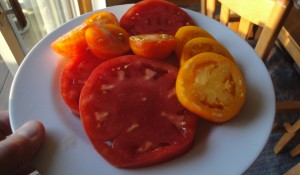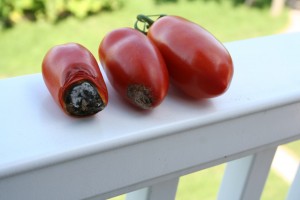Tomato Diseases in 2013

All in all, 2013 seems to be a very good year for tomatoes. We’ve had ample rain (maybe a little too ample at times) and we have not had the extended hot and humid spell that we’ve had in previous years that caused blossoms to drop. Gardeners in northern Minnesota have experienced a lot of cold nights, which has slowed ripening, too.
What tomato diseases have been out there this year? Two that we have seen and heard about are blossom end rot and early blight.

Blossom end rot can be a problem whenever there is inconsistent rainfall. We’ve had some big downpours this year and some stretches with less rain. Generally, tomatoes like an inch a week of water–spread out over two waterings. Don’t let the soil dry out completely because that is when the plants stop absorbing calcium, which causes the disease. Here’s an earlier article from the blog on basic tomato care with a good section on blossom end rot.
While there are many tomato diseases, the one we’ve noticed is early blight. Caused by the fungus Alternaria solani, it manifests itself in dark spots and yellowed leaves on tomatoes. The disease overwinters in soil and plant residue. It may be transferred to new plants via wind or splashed water. In very severe cases, the disease spreads to the fruit and you can lose a crop entirely. However, most cases are not severe and, while your tomatoes will look lousy, you can still get a crop. To manage early blight, clean up plant residue in the fall and throw all diseased plants in the trash, rather than the compost. Water plants at the base of the plant and avoid splashing water on leaves as much as possible. This web page has some useful photos for identifying early blight.
How are your tomatoes holding up?

3 Comments
-
Pingback: What Is Wrong with My Tomatoes?Notes from Northern Gardener
-
Pingback: July Garden Chores - Minnesota State Horticultural Society
-
Pingback: What Is Wrong with My Tomatoes?
Back to Blog